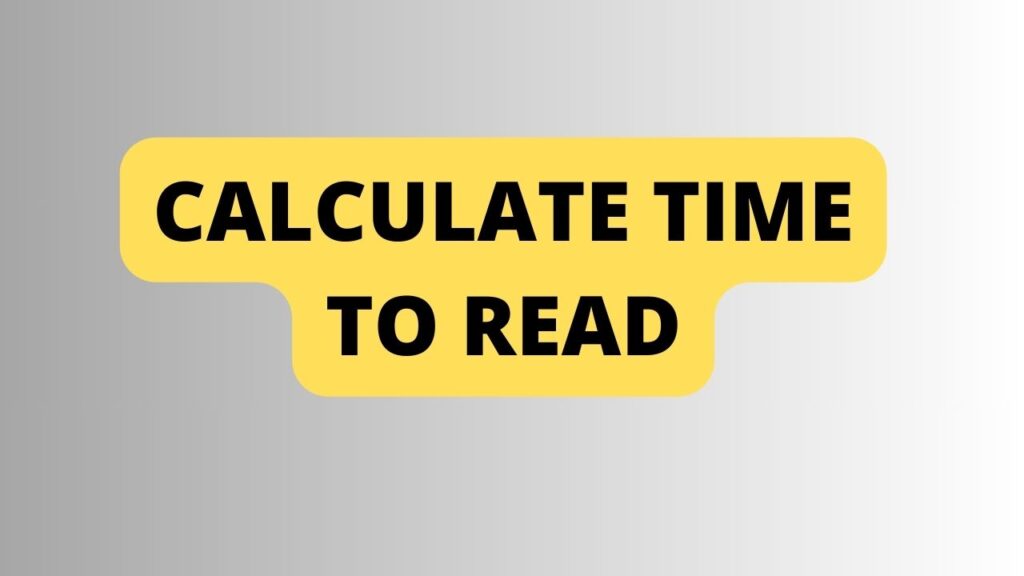Introduction
In the digital age, Calculate Time to Read where content consumption is rapid, understanding the time it takes to read an article or blog post becomes pivotal. But what exactly is “time to read”?
Understanding Time to Read
Understanding time to read involves considering various factors that impact reading pace. Elements like text complexity, your reading speed, and content formatting significantly influence how long it takes to digest information.
Factors Influencing Reading Time
Reading speed is a personal metric influenced by multiple factors:
- Content Complexity: Dense or technical content might take longer to comprehend.
- Reader’s Proficiency: Your familiarity with the subject affects reading speed.
- Formatting: Well-structured content with headers and bullet points facilitates quicker reading.
- Language Complexity: Vocabulary and sentence structure influence reading pace.
Techniques to Calculate Time to Read
Using Word Count and Reading Speed
One popular method is to divide the word count by your average reading speed. For instance, if an article has 1000 words and you read at 200 words per minute, it would take around 5 minutes to finish.
Tools and Online Calculators
Several online tools offer convenient ways to calculate reading time. They consider factors like word count, reading speed, and complexity to estimate the time required.
Improving Your Reading Speed
Enhancing your reading speed enhances comprehension and efficiency. Here’s how:
- Practice Regularly: Regular reading sessions can naturally boost your pace.
- Use Finger Tracing: Physically guiding your eyes along the text can increase speed.
- Eliminate Subvocalization: Minimize pronouncing words in your head for faster reading.
- Expand Vocabulary: A broader vocabulary aids in faster comprehension.
Calculate Time to Read: Tips for Efficient Learning
Understanding the time needed to read helps in managing study schedules and optimizing learning experiences.
Setting Realistic Goals
Estimate reading time to plan study sessions effectively. Break down tasks based on calculated reading durations.
Skimming and Scanning Techniques
Skimming allows you to quickly grasp the main ideas, while scanning helps in locating specific information. Mastering these techniques saves time without compromising understanding.
What is Time to Read?
Time to read refers to the estimated duration a person might spend going through a piece of written content. It’s a valuable metric used to gauge user engagement and optimize content for better readability.

How to Calculate Time to Read
Determining time to read involves considering word count and reading speed. A simple formula divides the word count by the average reading speed.
Importance of Time to Read
Enhancing User Experience
Knowing how long it takes to consume content helps in creating reader-friendly materials. It allows content creators to tailor their writing style and structure to suit audience preferences.
Factors Influencing Time to Read
Complexity of Content
The complexity of vocabulary, sentence structure, and overall content intricacy significantly impacts the time it takes to read.
Techniques to Optimize Time to Read
Formatting and Structure
Employing techniques like using subheadings, bullet points, and concise paragraphs aids in enhancing the readability of content, consequently affecting the time readers spend on it.
Tools for Calculating Time to Read
Online Calculators
Numerous online tools and plugins are available to quickly estimate the time required to read an article. These tools consider various factors like word count and reading speed.
FAQs (Frequently Asked Questions)
How accurate are online time to read calculators? Online calculators provide estimations based on average reading speeds. However, individual variances in reading pace might slightly differ from these calculations.
Does the font type and size affect reading time? Yes, larger fonts or spacing might decrease reading time, while smaller fonts or cramped text could increase it.
Can reading speed be improved over time? Absolutely! Regular practice, employing speed reading techniques, and expanding vocabulary can significantly enhance reading speed.
Should I skim or scan every article I read? It depends on your purpose. Skimming for main ideas is helpful, while scanning is beneficial for specific information search.
How does reading comprehension relate to time to read? While faster reading is desirable, comprehension is key. Striking a balance between speed and understanding is crucial.
Is there an optimal reading speed for everyone? Reading speeds vary individually. The focus should be on comfortable and efficient reading, rather than a specific speed.
Conclusion
In conclusion, understanding how to calculate time to read is pivotal for content creators. By optimizing this aspect, one can significantly enhance user experience, ultimately leading to higher engagement rates.
